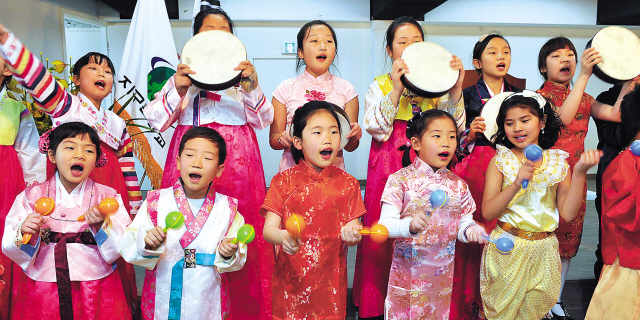About 42 percent of students from multicultural families said they were taunted by classmates in a 2010 survey conducted by the National Human Rights Commission.
Another survey by Seoul City showed that four out of five foreign teenagers were not in school, largely because of discrimination and bullying.
In May, a 17-year-old Russian-Korean was apprehended by the police for a series of arson attacks on houses and a school.
The boy said he had been ridiculed by his friends since his elementary school days due to his appearance. His father and grandmother had died when he was young and his mother refused to raise him.
From 2008 to 2011, the number of foreigners married to Koreans increased by almost 50 percent to 211,458 and the number of children from multicultural backgrounds aged 6 to 18 more than tripled to 151,154.
The multicultural population has expanded its role in Korean society. The 19th National Assembly has the first naturalized Korean legislator. The Army is set to see its first two non-commissioned officers from multicultural backgrounds in July.
“Despite multicultural families being on a steep rise in Korean society, the perception of Koreans toward them has not caught up yet. Koreans do not accept them as real Koreans,” said Yoon Pyung-joong, philosophy professor at Kangwon National University.
“We should face reality and change the standard of who is Korean. The social conflicts in France and the United Kingdom caused by ethnic problems are not a fire on the other side of the river.”
Experts say that Korea’s sense of racial and cultural homogeneity, a deep-rooted source of pride among Koreans, is the main cause of their bias against people with different appearances.
“People have emphasized for many years that Korea is a homogeneous country. So multiculturalism, which has been on the rise in recent years, is considered a threat to homogeneity,” said Koh Seon-ju, chairman of the Central Office for Multicultural Family Support Centers.
“Homogeneity propaganda helped unite Koreans in the past when they struggled through hard times from the Japanese colonial rule to more recently during the financial crisis in the late 1990s,” Yoon said.
“We are now living in a global society. People should expand the concept of what makes a Korean.”
A perverse and strong nationalism is also to blame for Korea’s difficulty in adapting to multiculturalism.
“When Japan lays territorial claims to the Dokdo islets, children blame Japanese-Koreans. When disputes with China rise, Chinese -Koreans become the target,” said Cha Yun-kyung, president of Korean Association for Multicultural Education.
Nadoni Luna, 29, a Bangladesh-born woman who married a Korean man 5 years ago points to barriers to foreign immigrants and their children.
“People judge me by how rich my mother country is, and how dark my skin is. They never see me as Korean, and I am worried about the lives of my future children,” she said.
“We, migrants alone, cannot break prejudice and discrimination against us. It will never happen by just our efforts. Multicultural families need help from all community members and a little understanding of difference” she said.
Students from multicultural backgrounds sometimes have difficulty with the Korean language, which affects their performance at school. Around 40 percent in a survey said they need Korean language education and assistance in basic school subjects.
“If their moms cannot speak Korean well, neither can their children. I hope the government and local governments provide more Korean language education for both multicultural moms and kids,” she said.
In March, the Education Ministry unveiled a set of policies to help children from multicultural families adapt to the Korean school system.
It plans to increase the number of preparatory schools from three to 26 nationwide next year. The schools will teach the Korean language and culture before they enter regular school.
There are 38,678 such students in primary and secondary schools, accounting for 0.55 percent of the total enrollment as of 2011. The ministry expects the percentage to reach 1.12 percent in two years.
Multicultural coordinators will be dispatched to immigration offices and regional education offices to make sure children receive such services and keep parents informed until they are assigned to regular schools, according to the ministry.
As for multicultural family support, 23 centers are running in Seoul and 201 nationwide. The centers provide assistance in child education and relationship counseling among family members.
They also hold some events where multicultural families can have the chance to introduce the culture of their mother country to Koreans.
More neighborhood facilities with easy access are needed, Koh said.
“Since multicultural families live dispersedly either downtown or in the countryside, more small scale offices are necessary near their neighborhoods.”
But most important is the whole society’s efforts to achieve harmony.
“More chances should be given to migrants and Koreans to socialize with each other at the centers or somewhere else. That way people could know better each other,” she sad.
By Kim Young-won (
wone0102@heraldcorp.com)








![[Today’s K-pop] Blackpink’s Jennie, Lisa invited to Coachella as solo acts](http://res.heraldm.com/phpwas/restmb_idxmake.php?idx=644&simg=/content/image/2024/11/21/20241121050099_0.jpg)